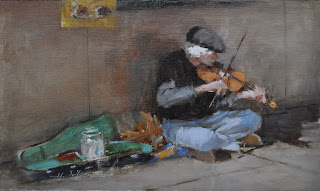
I have had several conversations recently with artists friends and students about painters, like myself, who paint an array of subject matter. I find it interesting that some artists are drawn to a varied, and very eclectic subject matter, while others seem perfectly satisfied to paint only one subject again and again.
I know the consequences of not sticking to one thing that an audience can identify an artist with, can possibly make it difficult to become known broadly for painting only one subject. I personally feel that the price one pays is certainly worth it......to me personally. Of course, I can only speak for myself when it comes to this matter. It would be maddening for me to have to get up every day, and know that the only thing one could paint was a subject that one was known for doing, and demanded by one's gallery representation, or collectors........no matter how much the artist enjoyed doing that particular subject. I guess if I were at a different time in my career, and had larger financial commitments than I presently have, my thinking on this might possibly be different.......maybe! There will always be those who want to categorize artists by the subjects they paint. Unfortunately, to a great degree, the fine art market is subject driven. I still believe and hope that good painting is appreciated by those who recognize it, no matter what the subject is.
I think many artists paint what they are comfortable painting. Most do not go out of their comfort zone regularly. Stepping out of that comfort area is something I like, and wish I were even bolder when it comes to trying new things. I like to think that I do to some extent, but it is a relative thing. One of my favorite contemporary painters,
Quang Ho, is a great example. He is a great painter, and also a fearless experimenter. He not only paints a varied subject, but he takes it further by continuing to experiment with his work, as it relates ot paint application and things of that nature. He successfully does this while remaining a traditional, representational painter. I hope that I never lose that desire to shake it up every now and then. This is my main reason for not painting only one subject. I think by being interested in a variety of subjects, it possibly keeps one fresh and keeps one from relying to much on tried and proven solutions. To some degree, one must do what they know will get the job done, but one does not want it to become familiar to the point of it being a formula.
The collection of paintings in the shot of my studio shown above, shows a variety of painting subjects.....some in frames, some not totally complete, but I think it represents what I am suggesting. The
"Smoked Mullet" painting to the right is one of these
"Other Subjects". It is almost complete. I have never painted this type of painting subject before, and I'm not sure how it will be recieved. It interested me, so I painted it. I still think it is an interesting subject, and I might explore it further. Whether or not it is a great painting is not the question. The process of getting it on canvas, and out of your system is sometimes the answer to the question. The process of painting, for me, is every bit as important as seeing the finished product. Many times it feels like it is a wasted effort, but I have always felt that something is gained, or learned with every painting session........if the artist is paying attention, and not just operating on auto pilot.
I think that temperament and personality has as much to do with this as it does with the style of painting artists choose to use to express themselves. I guess that is a related topic for another time.
 "Peaceful Summer Afternoon" 16x30 oil on linen is a larger version of a small painting I did last summer....."Summer Afternoon" 12x9 oil on linen. I always intended to do a larger one when I painted the study. There are always things that I am happier with in the studies, but overall, I think it translated fairly well into a bigger piece.
"Peaceful Summer Afternoon" 16x30 oil on linen is a larger version of a small painting I did last summer....."Summer Afternoon" 12x9 oil on linen. I always intended to do a larger one when I painted the study. There are always things that I am happier with in the studies, but overall, I think it translated fairly well into a bigger piece.

















































